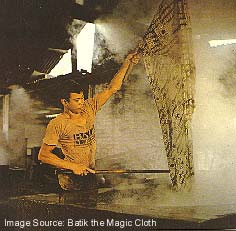How to do Batik, are more popular tought to wide community. Batik employers and collage also provide educational how to do batik on school children and public. They taught how to
do batik, procedures, and
usually use a small cloth handkerchief as an experiment. Thus, the process of
how to batik can be done in just a few hours and the cost involved is very
small. Tradition is great for introducing batik process to the public,
especially the younger generation.
The following is a sequential process of how to do batik
batik from beginning to end. Naming or any mention of how to work in every area
of batik can vary, but the core is doing the same.
 |
| Ngemplong part of process how to do batik |
1. Ngemplong
Ngemplong is the initial or preliminary stages of how to do
batik, beginning with a wash cloth. The goal is to eliminate the kanji. Then
proceed with pengeloyoran, which include cloth to castor oil or peanut oil that
is already in the straw ash. Incorporated into the cloth so that castor oil
cloth becomes weak, so that the absorption of the dye is higher.
After going through the above process, given fabric starch
and dried. Next, do the pengemplongan, which hammered cloth to smooth fabric
lining for easy how to do batik.
 |
| Memola part of process how to do batik |
2. Nyorek or memola. Memola Is the process of copying or making patterns
on cloth by copying an existing motif pattern, or commonly referred to ngeblat.
Patterns are usually made on paper rolls first, and traced the pattern on the
cloth. This one of how to do Batik stage, can be done directly on the fabric or trace them using a
pencil or canting. But the coloring process to be successful, do not break, and
perfect, then the process how to do batik needs to be repeated on the side
batik fabric underneath. This process is called Ganggang
 |
| Mbathik part of process how to do batik |
3. Mbathik. It is the next stage of how to do batik , in a
way to carve night batik cloth, starting from nglowong (draw the lines outside
of the pattern) and Isen, Isen (fill patterns in various forms). In the process
of Isen, Isen there nyecek term, which is making the stuffing in a pattern that
was made by way of giving the points (nitik). There is also a term nruntum,
similar to Isen, Isen, but more complicated.
 |
| Nembok part of process how to do batik |
4. Nembok. Is the process of covering the parts that should
not be exposed to the basic color, in this case blue color, using malam.
Sections were covered with a thick layer of malam as if it is a retaining wall.
 |
| Medel part of process how to do batik |
5. Medel. Medel is a fabric dyeing process that has made batik
to color liquid repeatedly so get the desired color.
 |
| Mbirah part of process how to do batik |
6. Ngerok and Mbirah. In this process, malam on the cloth carefully scraped off using a
metal plate, and then the fabric is rinsed with clean water. After that, the
fabric aerated.
7. Mbironi. Mbironi is covered in blue and Isen, Isen
pattern form cecek or points using the night. In addition, there is also
ngrining process, ie the process of filling the missing pieces colored with a
specific motive. Typically, ngrining done after the dyeing process done.
 |
| Menyoga part of process how to do batik |
8. Menyoga. Menyoga soga comes from, which is a kind of wood
that is used to get the color brown. The way is to dip the cloth into the
mixture brown.
 |
| Nglorod part of process how to do batik |
9. Nglorod is the final stage in the process of making a
piece of batik fabric and batik using color barrier (evening). In this stage,
batik release the entire night (candles) by inserting fabric old enough color
into the boiling water. Once appointed, the fabric is rinsed with clean water
and then diangin-arginkan to dry. The process of making batik is quite long.
The process of beginning to end the process can involve several people, and the
completion of a stage of the process is also time consuming. Therefore, it is
natural that batik cloth worth quite high.
No comments:
Post a Comment